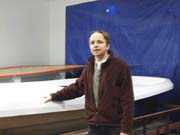The Maritime Educational Development Learning and Training Technology School has been operating for a year. Located in the Liberty Harbor Marina at the end of Louis Munoz Marin Boulevard, the MEDLATT school has received accreditation from the state of New Jersey and is offering a number of maritime-related courses in the future.
“For about two years now, we have been working on the idea of a camp to teach fishing and boat-building,” said Benny Axelson, one of the managers at MEDLATT.
In October of 2002, the MEDLATT school began its first course on boat construction. Axelson hopes this will be a springboard for an expansion in the school’s curriculum to embrace fishing techniques and marine biology.
“In the first class, we had five students,” said Axelson, a native of Sweden who came from a family a sea captains and fishermen. Axelson worked as a fisherman and a ships captain before starting at MEDLATT last year.
“The students were taught to build an 18-foot boat from the ground up,” explained Axelson. “The classes included not just hands-on work with boat construction, but theory on how boats are made.”
The class began with an introduction to working with fiberglass, which Axelson believes will benefit students beyond boat making.
“The students can take the information they have gained in working with fiberglass and work in other industries,” Axelson said. “They might be entry-level positions, but they would be ahead of the program.”
Speaking from his experience in the boating industry, Axelson said most of the entry level hires are made from pool of inexperienced people.
“Generally, the company has to provide training for the new workers,” said Axelson. “If the person going in knows something about the field, he has that much more of an advantage.”
Students participating in the classes also get courses in the electronic and mechanical aspects of boat manufacturing.
“They also get firsthand experience with navigation,” said Axelson, noting that education in maritime navigation has other benefits for students besides safely controlling a boat.
“The students get a sense of responsibility for the ship and the people who are on it,” said Axelson. “It is all a part of learning seamanship.”
As part of the first class, the five participants took a one-day boat trip to a small fish farm near Vernon, N.Y.
“The trip takes a while, but it’s a good idea,” Axelson noted. “The fish farm is connected to the MEDLATT and the students see how things operate there. Basically, the fish are grown to a certain length in self-contained pools. The fish are feed so much, which makes them grow proportionally.”
The encounter with the fish farm, while not directly connected to learning how to build a boat, is an important part of the curriculum.
“We want to foster an awareness of the ocean and of marine biology,” stated Axelson. “Many people who live in Jersey City don’t realize they live by a big body of water.”
Boat building, however, remains at the core of the class MEDLATT offers.
“The foundation of the boat is made in the mold,” Axelson explained. “That is where the shape of the boat is made.”
Students learn to shape the fiberglass to fit the mold, Axelson said. The molds themselves are created from blueprints. Different aspects of boat production are taught by four volunteer teachers, each of whom has had experience in marine architecture and boat structure. The classes usually run a month and are conducted five days a week.
“A lot of the boat-building in New Jersey is done in South Jersey,” Axelson said. “I would like to see the industry move up here. There is no lack of customers in our area.”
To prove his point, Axelson noted there are approximately 3,000 boat slips at the various marinas in Jersey City alone.
“When you count in New York and the rest of the Hudson, you have a lot of boat owners,” said Axelson. “The boats have to be taken care of and you need people to do that.”
Axelson said classes for the spring of 2003 will start on March 3 and run until July 29, with fall classes getting underway in September.
